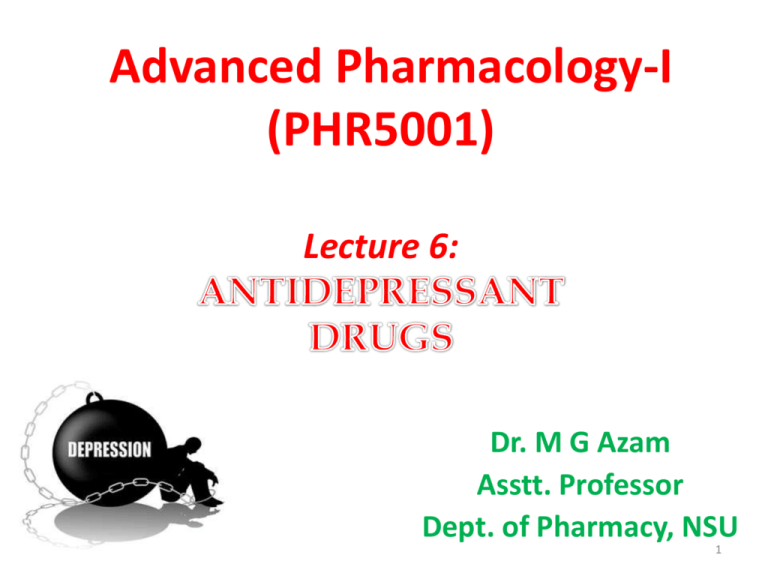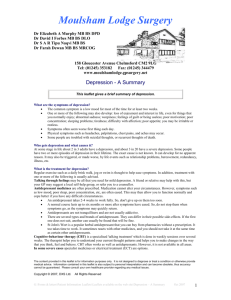ANTIDEPRESSANT DRUGS
advertisement

Advanced Pharmacology-I (PHR5001) Lecture 6: Dr. M G Azam Asstt. Professor Dept. of Pharmacy, NSU 1 Depression • Thought to result from a deficiency of norepinephrine or serotonin • Antidepressants increase the amounts of one of both of these neurotransmitters in the CNS synapse by inhibiting their reuptake in the pre-synaptic neuron • Most common mental illness characterized by depressed mood, feeling of sadness or emotional upset. • Mild depression occurs in everyone as a normal response to left stressors and losses. • No need for treatment Symptoms of depression vary from person to person. 2 key signs are loss of interest in things you like to do and sadness or irritability 2 Major Depression • As defined by the American Psychiatric Associations – Loss of energy, fatigue – Difficulty, thinking and concentrating – Loss of interest in appearance, work and leisure and sexual activities – Inappropriate feelings of guild and worthlessness – Loss or appetite or excess eating – Sleep disorders (hypersomnia or insomnia) – Obsession with death, thoughts of suicide • Major Depression causes symptoms that may: – Begin suddenly, possibly triggered by a loss, crisis or change – Interfere with normal functioning – Continue for months or years. 3 Bipolar affective disorder • Depression with periods of mania • People with this type of illness change back and forth between periods of depression and periods of mania (an extreme high). • Symptoms of mania may include: – – – – – – Less need for sleep Overconfidence Racing thoughts Reckless behavior Increased energy Mood changes are usually gradual, but can be sudden 4 What causes Depression? Family History – Having a family members who has depression may increase a person’s risk – Imbalances of certain chemicals in the brain may lead to depression Major Life Changes – Positive or negative events can trigger depression. Examples include the death of a loved one or a promotion. – Major Illnesses such as heart attack, stroke or cancer may trigger depression. 5 PATHOPHYSIOLOGY Not been fully understood yet. However, the development of antidepressant drugs associated with Norepinephrine, Serotonin & Dopamine systems Following are the receptor important in depression 5HT 1A 5HT 2A 5HT 6, 7 D2 Biogenic Amine Hypothesis: ↓ NE Permissive Hypothesis: ↓ 5-HT ↓ DA Theories of post synaptic changes in receptor sensitivity 6 PATHOPHYSIOLOGY Serotonin5HT and NorepinephrineNE in the brain Hypothalamus and Pituitary also may play important role in depression as they release hormone Prefrontal Cortex Limbic System Locus Ceruleus Raphe Nuclei (5-HT source) (NE Source) 7 Serotonin and Norepinephrine modulatory systems 8 Norepinephrine (NE) Serotonin (5-HT) Depressed Mood Concentration Sex Anxiety Interest Appetite Irritability Aggression Thought process Motivation • Dysregulation of Serotonin (5HT) and Norepinephrine (NE) in the brain are strongly associated with depression • Dysregulation of 5HT and NE in the spinal cord may explain an increased pain perception among depressed patients • Imbalances of 5HT and NE may explain the presence of both 9 emotional and physical symptoms of depression Amine theory After introduction of reserpine in 1950 it is evident that the drug those used for treatment of hypertension or schizophrenia may induce depression. Rserpine inhibit (deplete) storage of amine neurotransmitter such as serotonin and norepinephrine in the vesicles of presynaptic nerve ending Monoamine Hypothesis: Depression results from a deficit in one or 10 both of the serotonin and norepinephrine diffuse modulatory systems. 11 Treatment approach 1. Block the reuptake pump, such action help in temporary stay of neurotransmitter (serotonin and norepinephrine) at the postsynaptic ending and facilitate neurotransmission through corresponding receptors (by serotonin inhibition) 2. MAO inhibitor blocks major degradation pathway of neurotransmitter which permit more amount of neurotransmitter to accumulate and store at the presynaptic side. Tricyclic antidepressant Amitryptaline Nortryptaline Protryptaline Imepramine Desipramine Clopramine Trimipramine Doxepine 2nd and 3rd generation Amoxipine Bupripion Meprotiline MAO Trazodon inhibitor 3.Mirtazapine Phenelzine 3. Nefazodone Tranylcypra3.Venlafexine mine SSRIS: Selective 5HT reuptake Inhibitor Citalopram Esitalopram Fluoxetine (Prozac) Fluvoxamine Paroxetine (Paxil) Sertraline (Zoloft)12 Antidepressant Drugs • Monoamine oxidase inhibitors (MAOIs) – Prevent breakdown of monoamines – Must avoid foods high in tyramine – ‘cheese effect’ • Tricyclic antidepressants – Block reuptake of serotonin and norepinephrine – Safer than MAOIs • Selective serotonin-reuptake inhibitors (SSRIs) – Prozac, Paxil, Zoloft – No more effective than tricyclics, but side effects are few. • Results are comparable with MAOIs, tricyclics, and SSRIs – About 50% improve, compared to 25% of controls • Lithium – mood stabilizer – Not a drug – treats bipolar 13 Tricyclic antidepressants (TCAs) 3rd generation 14 Preclinical Evaluation of antidepressant drugs Invivo Test 1. Force swim test 2. Rotarod performance test 3. Locomotors activity Open field Close field 4. Elevated Plus maze Test Invitro test 1. Radioligand binding Assay for GABAa receptor 2. Enzymatic fluromatric assessment of cAMP/Adenyle cyclase activity 15 1. Forced Swimming Test This is a test of behavioral “despair” or learned helplesssness. Immobility is interpreted as a passive stress-coping strategy or depression-like behavior . A new behavioral method for inducing a depressed state in mice. One hour after I. P administration of anti-depressant drugs mice are dropped into the cylinder and left for 6 minutes. The immobility of last 4 minutes is counted. Cylinder : Height- 25, diameter-10cm, depth of water- 6 cm , temp-21-23 ° C. 16 Antidepressant drug will reduce the immobility 2. Rotarod Performance Test Scientific uses: Used to asses the motor function. Drugs such as Anti-depressant Anxiolytic ( Benz) Serotonin agonist and antagonist Specification: Animal diameter width Mice 30mm 60mm Rats 60mm 85mm Constant mode- 1-6 0rpm Rotarod performance test is based on a rotating rod with forced motor activity being applied, usually by a rodent. In the test , a rodent is placed on a horizontally oriented rotating cylinder (rod) suspend above a cage floor which is low enough not to injure the animals but high enough to induce avoidance of fall. Rodent naturally try to stay on the rotating cylinder and avoid falling to the ground. The length of the time that a given animal stay on this rotating rod is a measure of their balance, coordination, physical condition 17 and motor planning 18 3.a. Open Field Locomotors Activity serve as good preliminary test to determine motor deficit and anxiety Parameters are measured a. amount of distance traveled b. Observation of various horizontal, vertical and stereotype behavior. c. grooming (removal of dirt) d. Rearing b. Closed field Locomotors activity measurements Using Opto 3 Multichannel activity monitor- Swiss albino mice are individually placed in plastic cages and then the crossing of each individual channel (ambulation) are counted from 2 to 6 minutes. 19 Dark-Light Test 20 4.Elevated Plus Maze Test (EPM): Handling of animals before testing: Experience with handling , stress or injections can alter behavioral response of rodents in the elevated plus maze test. It is important to ensure that in the experiments using the elevated plus maze, handling of rodents and any experience with prior stress, particularly before testing is constant across animals and treatment groups. Specification: Automated device produced by Campden Instrument LTD. Two open arms 50X10cm Two enclosed arms- 50X 10X (30h) cm Height from the floor grid- 50cm Experimental requirements: The plus maze place in the dark room and center of the apparatus required to illuminate with 25 W electric bulb hanging above 100cm. This apparatus may connected to PC to 21 facilitate the counting Open field test, elevator plus maze test, and dark/light box These test can work as an antidepressant screen by measuring anxiety-related behavior as an accompanying depression. It is known that some antidepressants administration will cause a decrease behavior in these tests just like anxiolytics. However, the response to some antidepressants couldn’t be detected. Besides, these tests has their own problem. It is difficult to discriminate decreased anxiety-related avoidance from increased novelty-seeking in these tests. 22 In Vitro Test 1. Radioligand Binding Assay Receptors name 5HT1A Radioligands (3H)-8 OH-DPAT Site of the brain Rat hippocampus 5HT2A (3H)-Ketanserin Rat cortex 5HT6 (3H)-LSD HEK293 5HT7 D2 (3H)-LSD (3H)-Spiperon HEK 293 Rat striatum Total binding=specific binding + non-specific binding 23 Sample are required to collect from the respective site in the isotonic phosphate buffer (50mM Na2/K phosphate buffer containing 37.8mM Na2HPO4 and 12.2 mM KH2PO4), PH -7.4 and homogenized using polytron homogenizer. The homogenate centrifuges at suitable (18000rmp) for 30 minutes at 4 0C. The pellets are resuspended in ice cold buffer (50 mM Na /K2 phosphate) and served as receptor sample for radioligand binding assay. In case of HEK 293, cells are lysed using hypertonic buffer and samples are used for radioligand binding assay. Full length of 5HT6, 7 receptor gene can be obtained from PCR from human brain cDNA library, sub-cloned into a mammalian 24 vector, PcDNA (Invitrogent) and stably expressed in HEK 293 cells . 2. Measurement of cAMP production/ Adenyl Cyclase activity 25 26 Steps for reaction 1. Conversion of cAMP & enzymatic destruction of non cyclic adenosine nucleotide and phosphorylation 2. Conversion of cAMP into ATP 3. Enzymatic amplification of ATP 4. Conversion of F6P to NADPH 27 28






